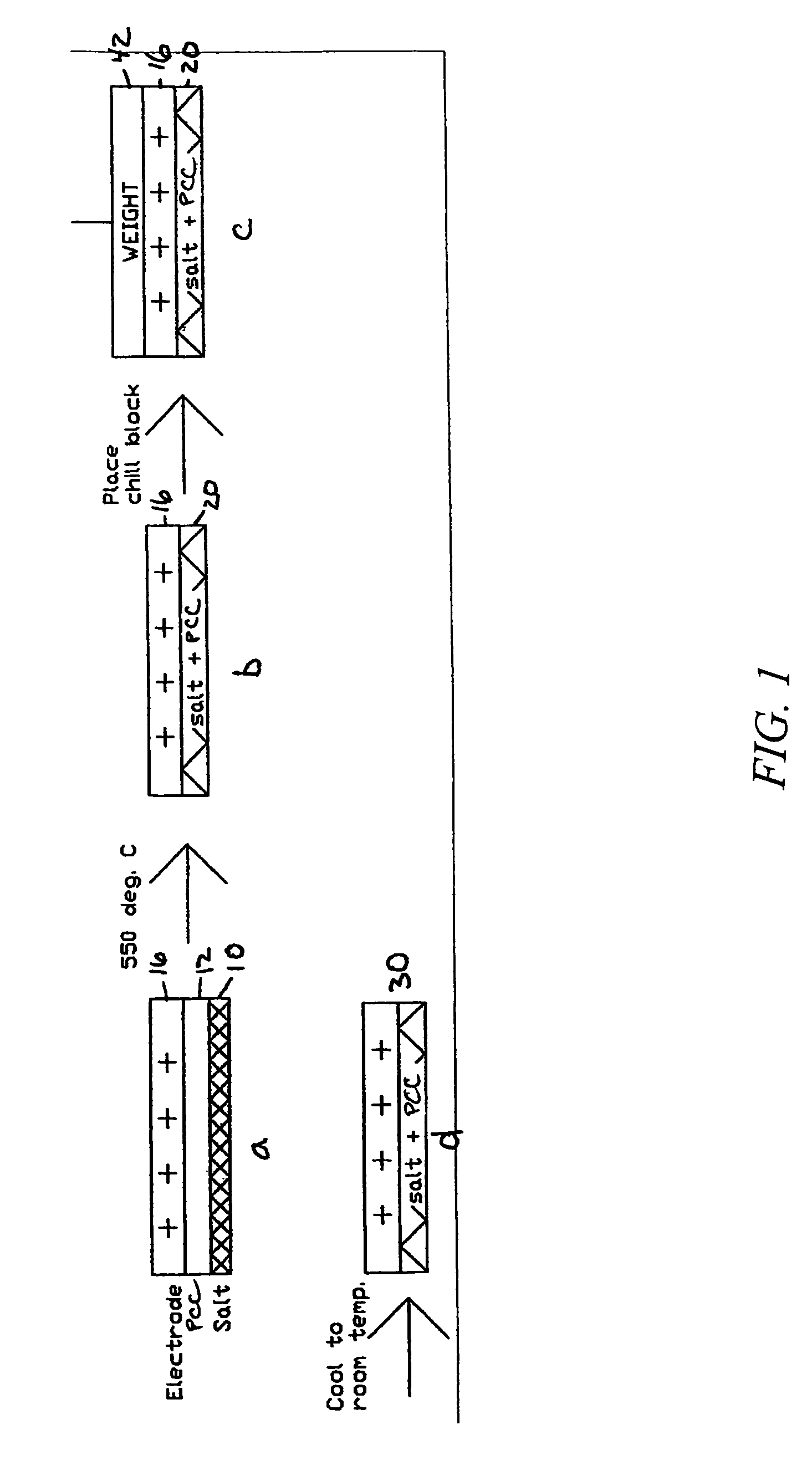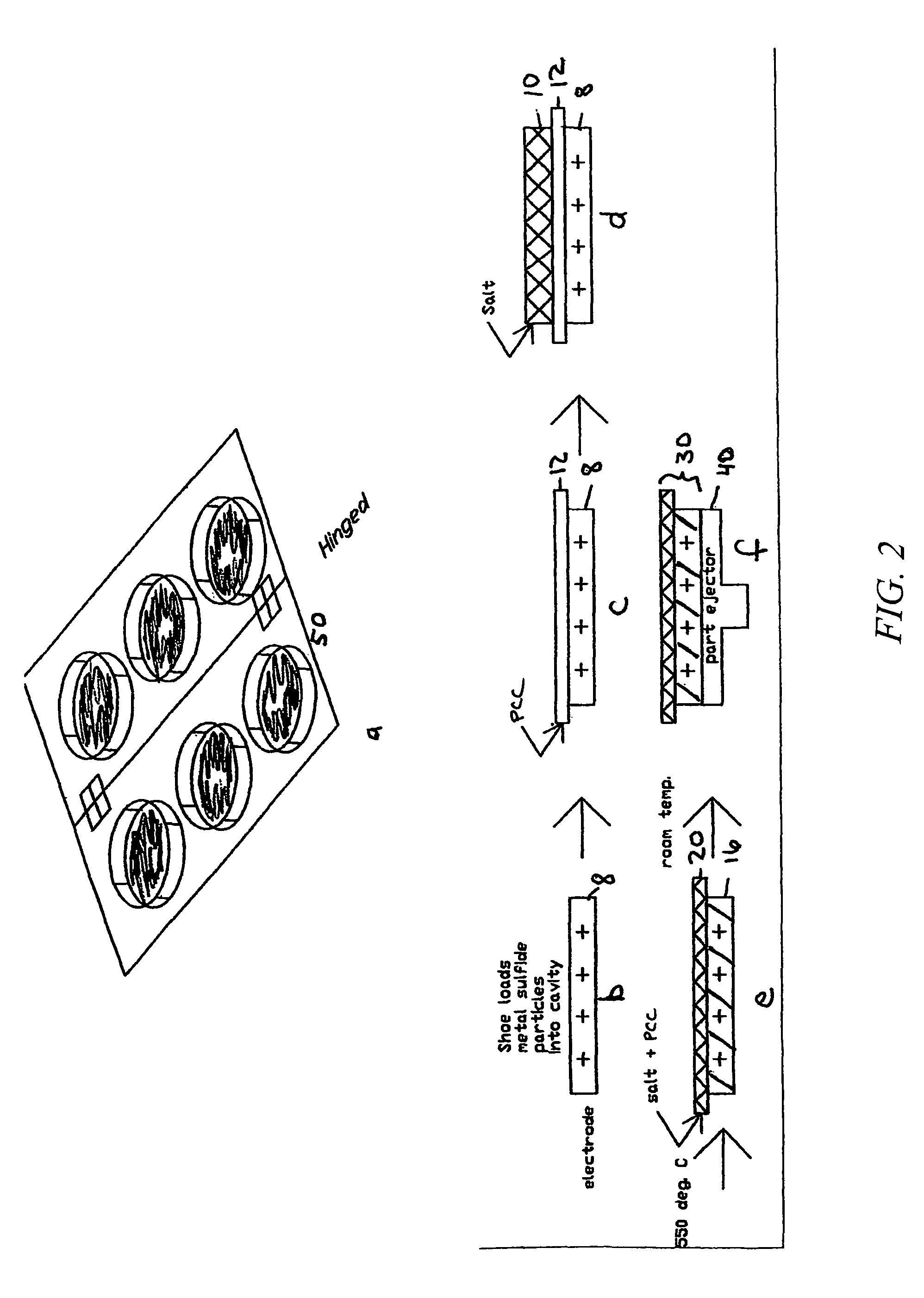Flexible, porous ceramic composite film
a composite film, porous technology, applied in the direction of cell components, cell component details, electrochemical generators, etc., can solve the problems of high production cost, limited structural stability of materials, undesirable limits on the thinness of separators, etc., to achieve surprising flexibility and handling strength
- Summary
- Abstract
- Description
- Claims
- Application Information
AI Technical Summary
Benefits of technology
Problems solved by technology
Method used
Image
Examples
example 1
Production of a PCC Film
[0052]A PCC film is prepared by using a blender to suspend 3.0 grams of ceramic fiber (composition of 75 / 25 weight % Al2O3 / AlSiO2 comprising SAFFIL® Al2O3 fibers from ICI, and FIBERFRAX® AlSiO2 from Carborundum) in 0.5 liters water. The fiber then is dispersed in 8 liters of water in a papermaking machine and dropped onto a 250 mm diameter fine polyester mesh at a 6 mg / cm2 loading to provide a 250 micron thick fiber mat layer, which is then drip dried. The mat then is infiltrated at with magnesium acetate (applied as a 0.6 g / mL aqueous solution containing 5 volume % isopropanol) and dried. The infiltration and dying is repeated at least once to provide a ceramic fiber paper. Addition of isopropanol aids in wetting the ceramic fibers and enhances the drying rate. Drying is done in flowing air at about 75-100° C. After drying about 2 hours, the resulting ceramic fiber paper can be peeled from the fine polyester mesh. The pieces of ceramic fiber paper are cut to...
example 2
PCC Film Laminated with Pressed Electrode Pellet
[0057]A PCC film is prepared by using a blender to suspend 1.5 grams of ceramic fiber (composition of 75 / 25 weight % Al2O3 / AlSiO2 comprising ALTRA® Al2O3 fibers from Rath, Wilmington, Del., and Z-90 SAZ® P-15 AlSiO2 from K Industries, Livonia, Mich.) in 0.5 liters water. The fiber then is dispersed in 8 liters of water in a papermaking machine and dropped onto a 250 mm diameter fine polyester mesh at a 6 mg / cm2 loading to provide a 250 micron thick fiber mat layer, which is then drip dried. The mat then is infiltrated with magnesium acetate (applied as a 0.6 g / mL aqueous solution containing 5 volume % isopropanol) and dried. The infiltration and dying is repeated at least once to provide a ceramic fiber paper. Addition of 5 volume % isopropanol aids in wetting the ceramic fibers and enhances the drying rate. Drying is done in flowing air at about 75-100° C. After drying about 2 hours, the resulting ceramic fiber paper can be peeled fro...
example 3
PCC Film Laminated with Electrode Particle Bed
[0060]A cut 250 micron thick PCC film as produced in Example 1 is positioned onto a cavity that has been filled with FeS2 particles, as shown in FIG. 2. The cavity is coated with BN to eliminate sticking to the cup. In this procedure, 2.3 g of the LiCl—LiBr—KBr electrolyte mixture used in Example 2 was placed onto the PCC film—this amount of electrolyte is sufficient to infiltrate both the PCC film and electrode FeS2 electrode powder. The arrangement of materials is then passed through a 550° C. tunnel furnace. After the electrolyte melts and infiltrates the two component layers, the electrolyte-to-separator weight ratio is 87:13 and the electrolyte-to-FeS2 cathode weight ratio is 25:75. The electrolyte-infiltrated PCC film becomes laminated to the FeS2 / electrolyte pellet via the infiltrated electrolyte salt.
PUM
| Property | Measurement | Unit |
|---|---|---|
| diameter | aaaaa | aaaaa |
| thickness | aaaaa | aaaaa |
| thickness | aaaaa | aaaaa |
Abstract
Description
Claims
Application Information
 Login to View More
Login to View More - R&D
- Intellectual Property
- Life Sciences
- Materials
- Tech Scout
- Unparalleled Data Quality
- Higher Quality Content
- 60% Fewer Hallucinations
Browse by: Latest US Patents, China's latest patents, Technical Efficacy Thesaurus, Application Domain, Technology Topic, Popular Technical Reports.
© 2025 PatSnap. All rights reserved.Legal|Privacy policy|Modern Slavery Act Transparency Statement|Sitemap|About US| Contact US: help@patsnap.com



